
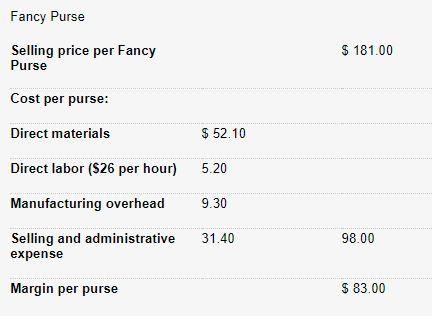

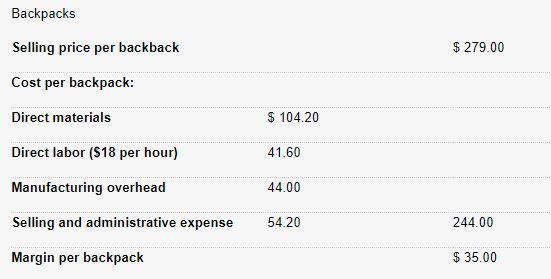

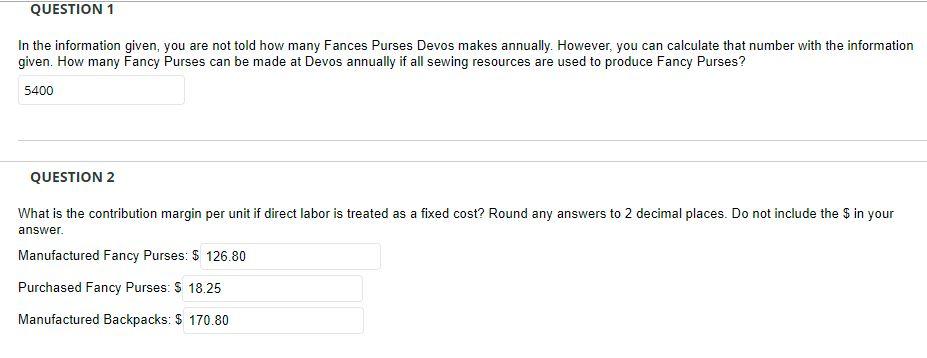
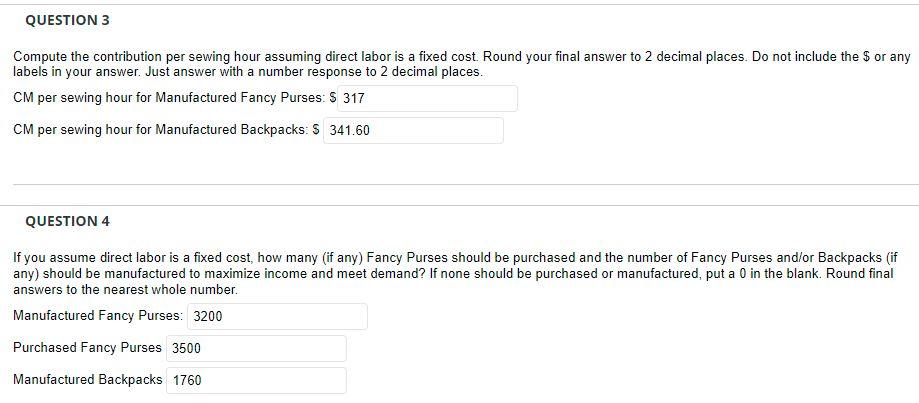
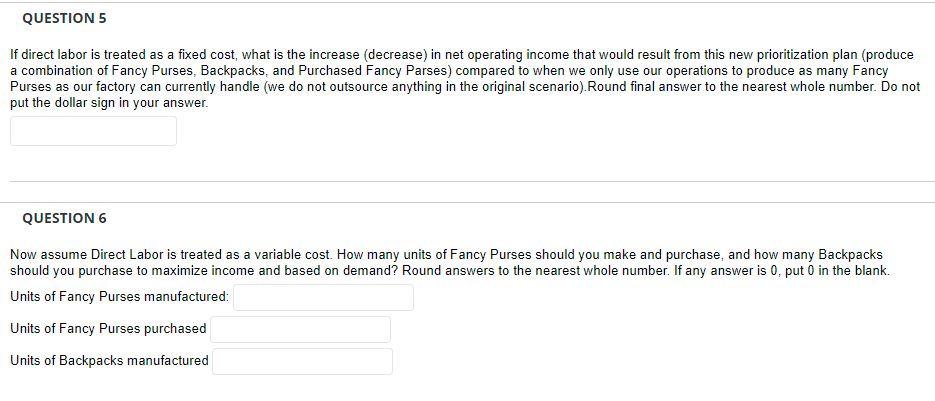

Devos Inc sells a wide range of purses, pants, and other clothing that are used in the fashion industry. One of the company's products is a purse, called the Fancy Purse. Production is constrained by the capacity of an automated sewing machine. A total of 2,160 hours of sewing time is available annually on the machine. Because each purse requires 0.4 hours of sewing machine time, annual production is limited to the amount of sewing hours available annually. At present, the sewing machine is used exclusively to make the Fancy Purses. The accounting department has provided the following financial data concerning the Fancy Purse: Fancy Purse Selling price per Fancy Purse $ 181.00 Cost per purse: Direct materials $ 52.10 Direct labor ($26 per hour) 5.20 Manufacturing overhead 9.30 31.40 98.00 Selling and administrative expense Margin per purse $ 83.00 Management believes 6,700 Fancy Purses could be sold each year if the company had sufficient manufacturing capacity. As an alternative to adding another sewing machine, management has considered buying additional Fancy Purses from an outside supplier. Slappy Inc, a supplier of quality fashion products, would be able to provide up to 4,400 Fancy Purses per year at a price of S162 per Fancy Purse, which Devos would resell to its customers at its normal selling price after appropriate relabeling. Johanna Doe, Devos' production manager, has suggested that the company could make better use of the sewing machine by manufacturing Backpacks, which would require 0.5 hours of sewing machine time per Backpack and yet sell for far more than the Fancy Purses. Johanna believes that Devos could sell up to 1,760 Backpacks per year to Backpack manufacturers at a price of $279 each. The accounting department has provided the following data concerning the proposed new product: Backpacks Selling price per backback $ 279.00 Cost per backpack: Direct materials $ 104.20 Direct labor ($18 per hour) 41.60 Manufacturing overhead 44.00 Selling and administrative expense 54.20 244.00 Margin per backpack $ 35.00 The Backpacks could be produced with existing equipment and personnel. Manufacturing overhead is allocated to products on the basis of direct labor-hours. Most of the manufacturing overhead consists of fixed common costs such as rent on the factory building, but some of it is variable. The variable manufacturing overhead has been estimated at $1.35 per Fancy Purse and $1.90 per Backpack. The variable manufacturing overhead cost would not be incurred on Fancy Purses acquired from the outside supplier. Selling and administrative expenses are allocated to products on the basis of revenues. Almost all of the selling and administrative expenses are fixed common costs, but it has been estimated that variable selling and administrative expenses amount to $.75 per Fancy Purse whether made or purchased and would be $2.10 per Backpack. All of the company's employeesdirect and indirect-are paid for full 40.00-hour work weeks and the company has a policy of laying off workers only in major recessions. As soon as your analysis was shown to the top management team at Devos, several managers got into an argument concerning how direct labor costs should be treated when making this decision. One manager argued that direct labor is always treated as a variable cost in textbooks and in practice and has always been considered a variable cost at Devos After all, "direct means you can directly trace the cost to products. "If direct labor is not a variable cost, what is?" Another manager argued just as strenuously that direct labor should be considered a fixed cost at Devos. No one had been laid off in over a decade, and for all practical purposes, everyone at the plant is on a monthly salary. Everyone classified as direct labor works a regular 40.00-hour workweek and overtime has not been necessary since the company adopted Lean Production techniques. Whether the sewing machine is used to make drums or frames, the total payroll would be exactly the same. There is enough slack, in the form of idle time, to accommodate any increase in total direct labor time that the bike frames would require. QUESTION 1 In the information given, you are not told how many Fances Purses Devos makes annually. However, you can calculate that number with the information given. How many Fancy Purses can be made at Devos annually if all sewing resources are used to produce Fancy Purses? 5400 QUESTION 2 What is the contribution margin per unit if direct labor is treated as a fixed cost? Round any answers to 2 decimal places. Do not include the $ in your answer. Manufactured Fancy Purses: $ 126.80 Purchased Fancy Purses: $ 18.25 Manufactured Backpacks: $ 170.80 QUESTION 3 Compute the contribution per sewing hour assuming direct labor is a fixed cost. Round your final answer to 2 decimal places. Do not include the $ or any labels in your answer. Just answer with a number response to 2 decimal places. CM per sewing hour for Manufactured Fancy Purses: S 317 CM per sewing hour for Manufactured Backpacks: S 341.60 QUESTION 4 If you assume direct labor is a fixed cost, how many (if any) Fancy Purses should be purchased and the number of Fancy Purses and/or Backpacks (if any) should be manufactured to maximize income and meet demand? If none should be purchased or manufactured, put a 0 in the blank. Round final answers to the nearest whole number. Manufactured Fancy Purses: 3200 Purchased Fancy Purses 3500 Manufactured Backpacks 1760 QUESTION 5 If direct labor is treated as a fixed cost, what is the increase (decrease) in net operating income that would result from this new prioritization plan (produce a combination of Fancy Purses, Backpacks, and Purchased Fancy Parses) compared to when we only use our operations to produce as many Fancy Purses as our factory can currently handle (we do not outsource anything in the original scenario). Round final answer to the nearest whole number. Do not put the dollar sign in your answer. QUESTION 6 Now assume Direct Labor is treated as a variable cost. How many units of Fancy Purses should you make and purchase, and how many Backpacks should you purchase to maximize income and based on demand? Round answers to the nearest whole number. If any answer is 0. put in the blank. Units of Fancy Purses manufactured: Units of Fancy Purses purchased Units of Backpacks manufactured QUESTION 7 Continue to assume that direct labor is a variable cost. Calculate what our income would be if we used up all 2,160 hours of sewing time producing Fancy Purses. Compare this to the output in the prior question. How much will income increase or decrease) if we treat direct labor as a variable cost and produce or manufacture based on our limited sewing hours and demands instead of using all 2,160 hours to produce Fancy Purses. Another way: What would be the increase (decrease) in net operating income that would result from prioritizing based on sewing hours and demand instead of using all 2,160 hours for production of Fancy Purses? (Treat DM as variable for both scenarios that you need to compare in this question. Round your answer to the nearest whole number. Do not include the $















